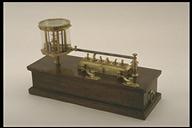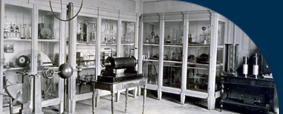|
OUR COLLECTION OF SCIENTIFIC INSTRUMENTS
HEAT |

 |
Absolute dilatometer |
 |
Dilatometro assoluto |
| Subjects: heat/ metal bar measuring device |
Settore: calore/misuratore della dilatazione lineare di sbarre metalliche |
| Inventory Number: 96 |
Numero di inventario: 96 |
| Engraved on the silvered quadrant: "Lana à Turin" |
Sul quadrante argentato “Lana à Turin” [inciso] |
| End of the 18th century |
Periodo: Fine del XVIII secolo |
| Mahogany, brass, glass, silver, iron, steel |
Materiale utilizzato: Mogano, ottone, vetro, argento, ferro, acciaio |
| 354 X 130 X 205 [mm] |
Dimensioni: 354 X 130 X 205 [mm] |
| |
|
This is a precision instrument designed to measure the variation of length of a small metal bar, when appropriately heated. This instrument was created and described for the first time by Petrus van Muschenbroek (1692-1761), an Astronomy professor in Leyden, who called it a “Pyrometer”. It was originally designed not to study heat but the thermic expansion of metals. Those studies were initially developed and carried out until the end of the 18th century by clockmakers, whose production progress depended also on adeguate knowledge of the thermic properties of the metals they were using, particularly for those concerning the pendulum. This model is signed by the geometer and mechanician Paolo Lana [1] (1750-1832). Its design is identical to the one reproduced in an engraving of Nollet’s famous Lectures of Experimental Physics (1764). In a catalogue of the early 19th century the dilatometer is described as a “brass machine, which is enclosed in a glass cylinder, to show the action of heat on metal objects, called the pyrometer”. The University of Urbino received it as a gift in 1805. |
Si tratta di un dispositivo di precisione idoneo a misurare le variazioni di lunghezza di una barretta metallica, opportunamente riscaldata. Questo strumento fu descritto per la prima volta nel 1731 da Petrus van Musschenbroek (1692-1761), professore di astronomia a Leida, che gli diede anche il nome di «Pirometro». Esso fu ideato originariamente non per studiare il calore bensì l'espansione termica dei metalli. Questi studi furono inizialmente sviluppati e portati innanzi per tutto il XVIII secolo dagli orologiai i cui progressi di produzione dipendevano anche dalla buona conoscenza delle proprietà termiche dei metalli in uso, in special modo di quelli attinenti alla parte pendolare. Questo esemplare è firmato dal geometra e meccanico Paolo Lana [1] (1750-1832). Il suo «design» è identico a quello riprodotto in una tavola delle celebri Lezioni di Fisica Sperimentale (1749) del Nollet. In un inventario degli inizi dell'ottocento, il dilatometro viene indicato come «una macchina d'ottone incassata in un cilindro di vetro per dimostrare l'azione del calorico sui corpi metallici detta pirometro». L'Università lo acquisì intorno al 1805 in seguito ad una donazione. |
| |
|
Description: The device is attached to an elegant mahogany support, which has a drawer in which the different metals bars could be stored. A mobile warmer entirely of brass with six wicks heat the bar. This is attached at one extremity to a small brass column by means of a brass screw and it is free to expand by dilatation at the other extremity, thereby acting up on the mechanisms that amplify the elongation. The brass mechanisms are clearly visible under a protecting glass cylinder. The dilatations of the metal to be examined are recorded on a silver-plated alloy quadrant through two light metal pointers. The less precise pointer, which moves along a smalle fissure placed vertiacally along the quadrant, records a maximum difference of 4 mm on a scale with eight 0,5 mm-marks. The more precise one is a pointer that rotates on circular scale that is divided into two hundred 2,5 m-marks. Even the 0,5 m-marks are easily read on the scale. On the quadrant there is inscribed “Lana à Turin”. |
Descrizione: L'intero dispositivo è montato su un elegante basamento in mogano, munito di cassetto per riporvi le diverse aste metalliche. Un fornello mobile a sei stoppini, interamente d'ottone, permette il riscaldamento della barretta metallica. Questa è bloccata ad un'estremità su una colonnetta d'ottone mediante una vite anch'essa d'ottone ed è libera di allungarsi per dilatazione nell'altra estremità, agendo così sui meccanismi che amplificano gli allungamenti. Questi sono incassati e ben visibili sotto una protezione cilindrica di vetro. Due leggeri e sottili indicatori metallici posti su un quadrante in lega metallica argentata registrano l’allungamento. Il grossolano, che si muove lungo una piccola fessura verticale del quadrante, ha una escursione massima di 4 mm, su una scala di otto tacche da 0,5 mm. L'indicatore più fine, una lancetta ruotante, si muove lungo una scala incisa circolare divisa in duecento tacche da 2,5 µm. Si riescono ad apprezzare bene anche le mezze tacche. Il quadrante porta incisa la dicitura «Lana a Turin». |
| |
|
Function: the burner is filled with “wine alcohol” (Nollet) and the bar is heated. As the bar is warmed, the rising and lifting mechanisms are triggered and the movement is henceforth transmitted to the aforementioned scales. It still works perfectly. |
Funzionamento: si riempie il fornello con dello “spirito di vino” (Nollet) e si riscalda la sbarretta. Questa allungandosi mette in movimento un sistema di leve e rotismi che trasmette il movimento amplificato ai due indici. Funziona tuttora perfettamente. |
| |
|
Bibliography: Nollet [1749], tomo IV, fig. 4, pp. 250-258. |
Bibliografia: Nollet [1749], tomo IV, fig. 4, pp. 250-258 |
| |
|
[1] Little is known about this able mechanician. In 1802 he was appointed Inspector of Weights and Measures in the Department of Turin. He invented the so called “general” steelyard for which he was awarded a silver medal and gratifying commendations by the R. Academy of Sciences (in the sessions of July 5, 1804 and of November 23, 1806). At the government’s request he moved to Milan in 1807, where he received other medals and other praises by the Academy for other useful inventions. |
[1] Scarne notizie abbiamo di questo valente meccanico. Sappiamo che nel 1802 gli venne affidato l'ufficio di Ispettore dei Pesi e delle Misure nel Dipartimento Torinese. Inventò una stadera detta "generale" che gli valse dalla R. Accademia delle Scienze (nelle sedute del 5 luglio 1804 e del 23 novembre 1806) una medaglia d'argento ed encomî lusinghieri. Passò nel 1807, dietro invito del governo, a Milano ove pure, per nuove utilissime invenzioni, ebbe dall'Accademia altre medaglie ed altre lodi |
|
|
|

